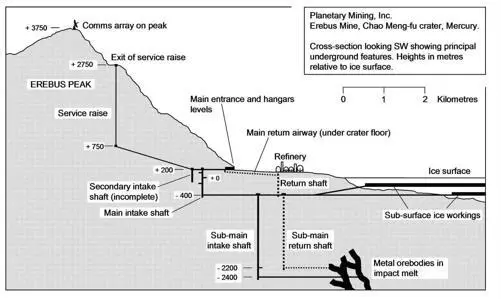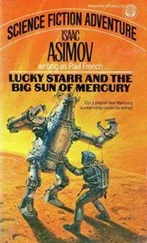They explored the chamber. Past the rail siding, there was a large confluence of pipes, cables and trunking, where they turned and dived abruptly into the ground, passing through the heavy-duty mesh grille that extended from floor to ceiling. There were two sets of sliding safety gates in the grille, set one above another, and a two-tier landing stage, with stairs that led from the floor to the upper set of gates.
Mining equipment and spare parts for routine maintenance lay stacked against the walls, loaded onto mine cars, or piled on the floor near the sliding doors.
A mess of small-diameter electrical cables hung down like vines from the roof of the chamber, where they had been torn from their mountings. There was comparatively little rubbish here; the hurricane of air that had emerged from the shaft appeared to have scoured the chamber clean of lighter debris.
They approached the grille. As they came closer, they heard the noise, a distant rush of air like the sound of a seashell held to one’s ear.
It was the sound of air moving in the depths of the mine, far, far below them, and with it came a smell, the faint scent that anyone who has worked in a large mine can never forget; the smell of broken rock, machine oil, and dank air in forgotten passages.
They had reached the main shaft of the mine.
Picture: Erebus Mine x-section
Abrams hooked his fingers into the dusty wire mesh and peered into the circular opening of the shaft. A gentle breeze stirred the hair on the back of his head. His flashlight beam played on the far side, about five metres away, then plunged down into the darkness of the shaft. Metal guide rails at the sides of the shaft glistened wetly in the beam, their surfaces thick with grease.
‘So this is the intake shaft, right?’ Elliott asked.
‘Yep. Men and materials only, in this shaft.’
As Matt spoke, he could visualise the air circulation of the big mine in his mind’s eye.
Every underground mine always had at least two main shafts. Air was forced down the intake shaft, round the labyrinth of passages deep underground, and back out again through the return shaft. At Erebus, the return shaft was nearly two kilometres away, out under the crater floor beneath the fuel refinery.
In the mine workings, pressure doors, like the one they had passed through earlier, controlled the flow of air and prevented any misrouting of the air current, so that the clean incoming air was forced to travel round the entirety of the workings before being allowed to return. In this way, any poisonous or inflammable gases released during mining and blasting were diluted to safe levels and swept away.
In a space mine, the air could not be allowed simply to escape once it had done its job; it had to be circulated continuously, and this created unique challenges for ventilation design. In the case of Erebus, the ice released from its primordial prison deep under the surface of the ice field contained methane, ammonia, carbon monoxide, and other gases trapped in the icy matrix. Released from the confining pressure, and warmed on its lengthy journey along the underground haulage ways, the ice gave up substantial quantities of potentially dangerous gases before it reached the processing plant.
These gases had to be extracted, along with water vapour, before the air could be recirculated. At the top of the mine’s oversized return shaft, which doubled as a buffer air reservoir, the cooled air was fed through a specialised part of the fuel refinery to extract the unwanted gases. Oxygen and nitrogen, extracted from the ice, were added to the air to correct the gas mix, before the air was returned via a long airway that led under the crater floor, back up to the main ventilation fans near the accommodation levels.
As the mine expanded, a pair of sub-main shafts had been sunk deeper into the crater. Starting from shaft heads cut into the rock 600 metres below them, the sub-mains penetrated a further two kilometres down towards Mercury’s iron core.
There the shafts emerged at the level of the metal-rich orebodies far below the crater, whose molten tendrils had solidified in the fractured rock when the crater had been formed in that titanic impact three billion years ago. In the deep stopes two-and-a-half kilometres underground, mining robots worked to break out the metal-bearing rock and load it onto the conveyors, at the start of its long journey back to the smelting plant on the surface.
The four of them moved away from the shaft entrance, looking for anything that would tell them more about the fate of the mine personnel.
Matt called Bergman over to the control panel for the hoist, and pointed to the status display. There was power to the hoist, as they had expected, and the double-decker cage was at the bottom of the main shaft, at the 400 level. The operator’s key was still in the console.
‘Think we should raise it?’ Matt asked.
‘Well, our mission’s going to be pretty short if it won’t come up. Let’s give it a try.’
Matt set the controls to bring the cage to the surface, held the interlock handle closed, and turned the control handle to start the hoist.
A shrill bell rang twice, and above them, in the unseen hoist motor chamber, the brake blocks shrieked as they were pulled off the hoist sheaves. The red lighting dimmed slightly as the motors sucked current, and behind the grille, the wire ropes began to move. The heavy counterweight fell past in its guide ropes, on its journey to the bottom of the shaft.
A faint thrumming came through the rock as the hoist picked up speed, and the wire ropes quickened to a glistening, metallic blur.
Two minutes later, the hum of the hoist motor started to slow, and a faint singing sound came from the guide ropes.
‘It’s here,’ Elliott said, and stood back, as the cage lifted up into sight behind the wire grille. The cage shook slightly as it slid into a set of four vertical guide rails, which steered it into the correct position in the shaft station. There was a squeal of seized guide wheels, a slowing of motion, then a thunk of heavy-duty brakes gripping the guide rails. The lights brightened as the hoist motor halted.
Both safety gates in the mesh moved aside, and the cage doors slid upwards, revealing the battered interiors. The floor of the lowest cage was fitted with a short section of rail track, to allow mine cars loaded with materials to be rolled aboard.
‘Okay, so the hoist works. What now?’ Elliott asked, ‘Are we going to go down into the mine, or continue with the plan?’
‘We stay on plan,’ Bergman said in an unhurried way, glancing at his watch. ‘We can’t afford to get distracted here. We’ve proved the hoist works, so we know we can come back here later, after we’ve got you guys to the service raise. Okay?’
The three of them nodded.
‘Right, I’m going to send the twelve hundred hours report, then we’ll get going again. Do you want to check out that loco and see if we can use it?’
Matt looked dubious, but he went over to the locomotive while Bergman tried to raise Clare’s team on the comlink.
Matt sat down on the locomotive’s dusty seat and wiped the control panel clean. He found the master switch and switched the power on, but there was no response from the controls; the batteries were completely dead. He looked back at Bergman, who was frowning at the comlink.
‘Any luck?’
Bergman shook his head. ‘They must be out of coverage. I’ll send a text letting them know where we are.’ He tapped at the keypad of the comlink for a few moments, and waited while the message went, then snapped the comlink shut. ‘Okay, guys, let’s move it.’
Читать дальше












